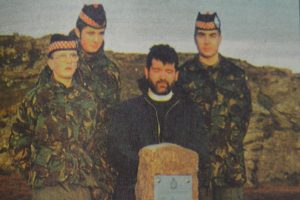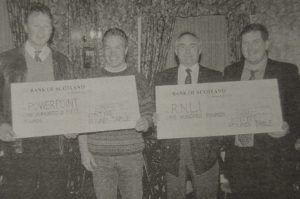TEN YEARS AGO
Friday November 1 2013
Top award for pipe major
Pipe Major Ian McKerral of Kintyre Schools Pipe Band has won a top award.
He received a thunderous applause when, during this year’s prestigious Glenfiddich Piping Championships at Blair Castle on Saturday, he was awarded the solid silver Balvenie Medal for services to piping.
Commander Wilson said it was a pleasure for him to hand the medal over to a fellow Campbeltonian.
Pipe Major McKerral thanked the many people who had helped him over the years. The pipe major can be heard speaking tomorrow on Radio Scotland’s Piping Live.
Ten top pipers from all over the world were invited to take part in the Glenfiddich championships including Campbeltown-born Willie McCallum, a winner of the event eight times.
This year, he finished third in the Piobaireachd and fourth in the March, Strathspey and Reel and third overall.

TWENTY FIVE YEARS AGO
Friday November 6, 1998
Remembrance on Mull of Kintyre
Prior to this coming Remembrance Sunday, army cadets joined with Southend minister the Reverend Callum O’Donnell to commemorate the lives of servicemen who died on the Mull of Kintyre.
They gathered on the Mull to lay a wreath at a special memorial stone dedicated to a plane crew who died in a crash almost 42 years ago.
A service to commemorate the crew of Neptune WX545, who lost their lives when their plane crashed onto the wind-swept hills during an exercise, took place on July 9 this year, when the stone was unveiled.
Veterans attended a church service in St Blaan’s Kirk before travelling to the scene of the crash to see the stone.
This second service, in which the wreath was laid, was a smaller and quieter affair, but held as much poignancy as the first one.
The memorial was built after veteran Ian Kirk, who had flown on the Neptune and had been taken off the crew the week before the crash, decided a memorial should be put up after visiting the site two years ago.

Round Table donations
Kintyre Round Table chairman Robert Mitchell and vice chairman Alex Arkell recently presented donations to Roy McMurchy of the RNLI and Jonathan Sharples of Powerpoint.
A total of £700 has been distributed by the Round Table to good causes in the area over the past few months.
As part of the Round Table’s community service, members will once again be getting into costume this Christmas for the annual sleigh ride around Kintyre. Santa and his ‘little’ helpers are busy preparing for what has become a local tradition.
The Round Table is always looking for new members who are keen to take part in a variety of activities. Forget any preconceived ideas you may have about Round Table – it is friendly, fun and rewarding.

FIFTY YEARS AGO
Thursday November 1, 1973
Oil!
Campbeltown has been designated as a secondary development zone for supplies and services in the interim coastal planning framework for North Sea oil and gas.
This means, in plain language, the setting up of an oil refinery on the Kintyre coast with all the services such an installation would need.
Informed local opinion puts the most likely site some miles north of Campbeltown on the east coast of Kintyre in the Ardnacross area. But it could be elsewhere further inland.
This would be in accord with the discussion paper issued last week by the Scottish Development Department. It includes a map showing oil development to be likely in a semi-circle covering the hinterland of Campbeltown with the town itself as the focus.
The report further states: “Campbeltown offers potential as a secondary supply and servicing base because of its harbour, which could be extended, in a strategic western location in relation to the western licensing area. The use of the harbour by the fishing industry should not preclude development.”
However, there are snags. The coastline of East Kintyre north of Campbeltown round to Ardyne Point is marked on the map as an area in which conservation considerations are particularly strong.
In such areas developers, says the paper, may expect to encounter difficulties in obtaining permission to develop sites.
Apart from any difficulties developers may have in buying suitable land, planning permission from the local authority, Argyll County Council, will be important.
Should these and other difficulties be overcome, employment prospects for Campbeltown look good. Labour will be needed for transport, providing homes, schools and social services, developing the site, providing power, water and drainage. There would appear to be scope for unskilled as well as skilled labour.
This is all to the good in Campbeltown. The unemployed pool of male labour in the area is 200 strong, but only 12 are skilled and 25 semi-skilled.
If and when oil comes, the prospect looks good for all of them, particularly as the other older established industries are also looking for labour.
But it does look as if there are not enough skilled and semi-skilled men to cope with the situation in Campbeltown.
Key workers will have to be brought in and housed. This would put a heavy strain on Campbeltown’s housing programme.
One possible solution would be a township of chalets or semi-permanent caravans near the oil site. And there is one firm already developing in the Campbeltown area which would surely welcome such an opportunity.
Let us hope the new permanent houses scheduled for the town go to people already here. Prospects for Campbeltown folk look better than they have done for a long time and if key workers do come in any number they will be excellent for local trade.
ONE HUNDRED YEARS AGO
Saturday November 3, 1923
Campbeltown War Memorial
This year marks the 100th anniversary of the unveiling of the Campbeltown War Memorial and its dedication.
The event took place in October, before Remembrance Day, and more than 5,000 people attended.
This photograph and the following are taken from the Courier’s report:
The memorial to the men from Campbeltown Burgh and Parish “who in the Great War, 1914-1919, gave their lives for their country” was unveiled and dedicated on Sunday, 21st October and the solemn ceremony which marked the occasion will not soon fade from the memories of the great company who were privileged to witness it.
The wonderful concourse of people who assembled “to keep their tryst with those who lie asleep” far from the place of their birth, was probably without parallel in the history of this district.
There must have been at least 5,000 persons assembled round the monument, which stands on the seaward side of Kinloch Park, a witness for all time to the part borne by the sons of old Campbeltown in the sacrifice which this generation was called upon to make in the testing years of the world’s greatest and cruellest war.
We have raised our memorial. We have dedicated it to its purpose worthily, for Sunday’s proceedings were a proof that the living have not the gallant dead and that we be touched in heart and memory of the years when we face the trials and sorrows of war together and by the remembrance of the brave youths who fared forth to the fighting line never to return.
The monument
The monument is of a vigorous old Scottish style, its rugged outline being suggestive of the Wallace Monument, Stirling.
It has a bold buttressed base of great strength, rising from a wide paved platform to which a flight of steps ascends on each of the four sides.
The Dedication Panel, of Elterwater green stone, is placed on the front face below the Cross of Sacrifice, while the other three sides are occupied by grouped panels of the same material bearing the names of the fallen, 349 in number.
The Cross is executed in rustic fashion in the centre of an arched recess, in silver grey granite from Kemnay Quarry, Aberdeen, thus relieving it against the background of Davaar Island stone, of which the tower itself is constructed.
This contrast will increase with time as, while the granite will always retain its present colour, the local stone will become darker with the years.
The monument is about 14 feet square and as feet high to the top of the small Cross of the apex.
The design has been composed with thoughtful ingenuity and is a fine example of the work of Mr Alexander N Paterson MA ARSA FRISA of St Vincent Street, Glasgow.
The building of the monument was carried out by Mr Neil Macarthur Campbeltown, and the workmanship is of an uncommonly meritorious character.